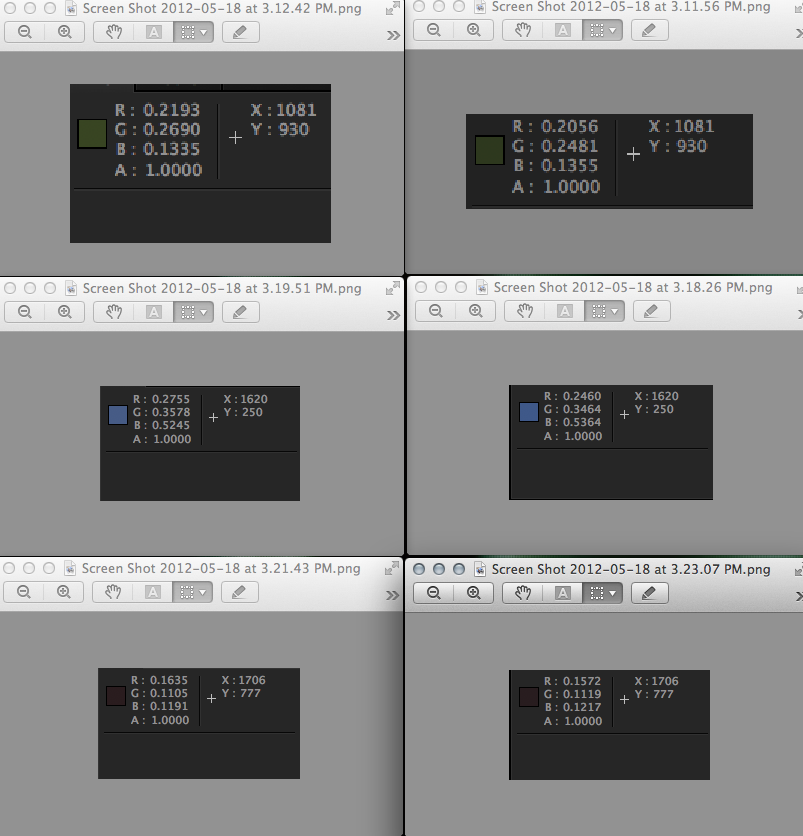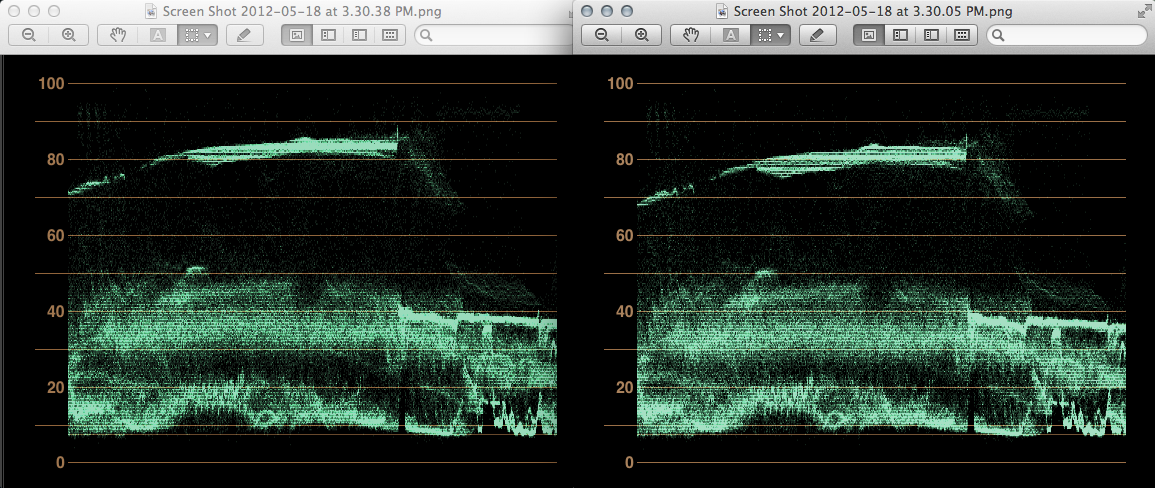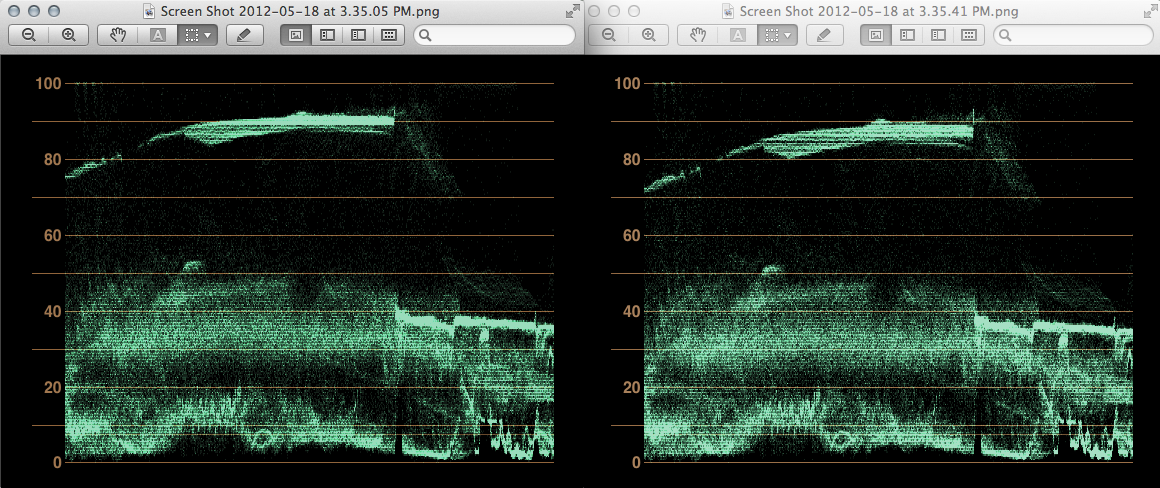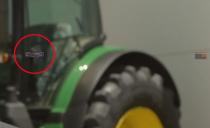
-
@kholi why not use .601 with 5DtoRGB?
-
Like I said before, Full Range is only useful when doing HEAVY grading, and by that I mean, bending the shit out of the image, only because it has less chroma smearing, but Kholi is right, it does compress the image into the middle, you gain nothing by doing it for most everyday uses. Chances are, you won't need to use "full"
[edit - Upon further study forget full - it doesn't really help you.]
-
So doing conversions with both 601full and 709full - yielded some interesting results. To the eye, the 601 images looked slightly warmer, and slightly brighter.
Pixel peeping revealed these results. 601 on the left 709 on the right.

which confirms what my eyes saw which is a weird shift in RGB values that does indeed skew towards a warmer, slightly more green image (as you know luma is tied to green in the RGB universe)
Waveform monitor shows slightly brighter image. but not lifted from shadows up... just stretched out through mids and highs. BUT the highlights are compressed

same stretching and compression on broadcast.
.


 Screen Shot 2012-05-18 at 3.24.11 PM.png803 x 836 - 116K
Screen Shot 2012-05-18 at 3.24.11 PM.png803 x 836 - 116K
 Screen Shot 2012-05-18 at 3.31.46 PM.png1155 x 488 - 471K
Screen Shot 2012-05-18 at 3.31.46 PM.png1155 x 488 - 471K
 Screen Shot 2012-05-18 at 3.38.04 PM.png1160 x 488 - 527K
Screen Shot 2012-05-18 at 3.38.04 PM.png1160 x 488 - 527K -
Why the hell are you guys converting your beautiful wider gamut rec.709 broadcast legal footage into the much smaller rec.601 colorspace? You understand you're just dumping away roughly 20% of your color gamut correct? And you understand the gh2 records broadcast legal luma information, there is no data below 16 or above 235 to magically recover. There is some insane misinformation propagated on this forum sometimes......
-
@Fohdeesha I agree. And it's not just that. After all the hype, I spent some time comparing 5DtoRGB conversions over the standard Log and Transfer FCP7 ones and soon joined the group of people that believe it's a hoax. For one, my tests have convinced me that chroma blurring/sharpening, not to be disruptive, has to be done not during conversion to prores, but only during CC, and to the level demanded by the particular shot. But I understand why there are people that like 5DtoRGB and I don't want to get into any argument. So I suggest everyone just test their workflow accurately before screwing up their footage by believing what I or anyone else write here (and on the web in general).
-
@rapsoe - Precisely - I wrote a more technical writeup over explaining, and eventually showing with 800% zoomed in examples, that Premiere's MTS interpreting (yuv to RGB conversion, legal vs ext. flagging, etc), are the exact same as 5dtorgb's - and in some tests, premiere's 4:2:0 YUV to 4:4:4 RGB conversion and chroma upsampling proved to be MORE detailed. I can't speak as to 5dtorgb's usability on a Mac with FCP, I've never used it - But I have heard that final cuts log and transfer can throw a fit with gamma issues sometimes
-
@Fohdeesha Thanks for the link. As for the Mac, QuickTime has always had to serve consumers as well as prosumers and there are many arguable compromises that have been made by the design team to do that. Luckily, FCP, at least until version 7, has never had that problem (even if plenty of others). As a rule of thumb, I make FCP handle everything it can on its own and try to resort to QT the least possible.
-
@Fohdeesha at least I had similar observations with Avisynth-VirtualDub workflow:
http://www.personal-view.com/talks/discussion/comment/57909#Comment_57909
(see pictures of tulips). It was sharper than 5DToRGB.
-
@fohdeesha I saw your comments on the thread, and the posted samples you provided, in my eyes had a very subtle difference. Not exactly, 'the same'/'no difference' you keep saying. I'm not doubting your credentials, but I did see a difference at 800%.
-
@itimjim - Exactly, and that's what I was getting at - in some areas, the premiere sample actually has MORE apparent detail. When taking into account these subtle differences, you have to keep in mind they are 800% blowups - only one out of every 8 pixels are actually in the original footage, the rest are being interpolated - the tiny differences you end up seeing are simply from the interpolation varying results due to the original compression. You can clearly see the chroma handling is the same, if not better with Premiere's engine, and even then you have to blow something up 8 times to see it.
-
Am I doing something wrong with 5D2RGB?
After processing a MTS file in 5D2RGB, the image really becomes "flat", ok.
But then after processing in Sony Vegas 11 Pro I see no any difference!
For example: I put both original .mts and 5d2rgb processed .mts files on the Sony Vegas timeline, then I use exactly the same plug-ins and filters on both .mts files.
After rendering out the both new videos look absolutely the same, no any difference and no any flatten look on the 5d2rgb processed file.
What format do I need to render out a file (post processed, graded, etc.), so that after that I can process it in 5D2RGB to make it flatten?
-
It would be great if you could convert more than one clip at a time on multicore machines as well. Right now I just duplicate the 5DtoRGB app 3 or 4 times and then split my footage up into groups to be processed by each instance, but you have to set it up manually which is just silly.
-
Been away for a while, but--since I'm the one that first asked the question to get this thread going--it's seems like the conclusions so far are:
In terms of image quality, 5dToRGB is most beneficial for those who:
- Need to transcode to Pro Res or DPX and
- Work in non-Adobe CS 5.5 (and above) environments
- (and don't want to use Avisynth solutions?)
- otherwise, in terms of image quality, 5dToRGB has limited / no benefits.
Best settings for Pro Res conversion are:
- Luminance Range: Broadcast (rather than Full)
- Decoding Matrix: 709
- Chroma mode set at (Default).
- Post processing set to (None).
- Gamma Correction to (1.0)
Does that sum it up? I'm especially interested about 1.
-
Anything faster than 5DtoRGB? Supposing I really want the look of the ITU-R BT.601 / Full Range / Default Chroma Mode that 5DtoRGB gives you (I know the arguments against it), but that I want to get that look faster, is there any other tool that will do the same?
The reason is that 5DtoRGB takes significantly longer to encode than all the other tools I've tried. I ran a test last night, converting a 32GB card full of video, Crossfire Night hack. Using Adobe Media Encoder it took 35 minutes to encode to ProRes 422 HQ. Using 5DtoRGB, it took 1 hour 45 minutes to encode. Yikes! We're doing a 48hr competition soon. If it takes that long for each camera, we're going to lose just on encoding files.
I've tried every other tool I can think of and I cannot achieve the same flat look. I've tried Adobe Media Encoder with Prores, DnxHD, Media Converter, importing into Premiere directly, etc.
Any thoughts? Thanks.
-
We are transcoding a ton of hacked GH2 footage for use in Media Composer 6. It will not import the hacked files so I am looking for an alternative. Would I be correct in thinking that using Adobe Prelude CS6 to transcode all the GH2 stuff will provide an equally good image quality DNxHD file as using 5DtoRGB ?
-
@iFilmFlops If speed is your concern, then just transcode using Adobe. Then use a custom color correction preset that approximates the look you want from 5dtoRGB. (Like others have said, the settings you want from 5dtoRGB aren't optimal from a color correction standpoint anyway).
@Nityananda_SCSMath Just run a test for yourself and see!
-
@iFilmFlops I've done a 48 hour film contest before, lots of fun, lots of camaraderie.. Not a great deal of time ;) I'd just use the MTS footage in PPro directly. Going from experience you're only going to have time to do a quick grade anyway.
-
Someone chime in on this issue
Full range vs. Broadcast range - I hear varying arguments for both sides.
My personal observation
Broadcast range looks exactly the same to log n' transfer.
Full Range gives me detail in the blacks just like the program is advertised to do and I notice WAY LESS NOISE and have never seen 1600-3200 ISOs look so good.
Yet I get called an idiot on that forum (paraphrasing) for advocating Full range. I don't understand why so many people advocate Broadcast range.
-
http://www.personal-view.com/talks/discussion/comment/63557#Comment_63557
It's about what's being done to the image - in the above link you'll see in the wfm that all it does is compress the waveform, stretching the blacks, and squeezing the highlights. You really gain nothing from using full. I've stopped using it, as I can duplicate what full gives me through a simple levels adjustment. And I start with an image that hasn't been "squished" in terms of luminance, which will effect your colors.
my process is organic. Always subject to change if I discover something new. So I have hopped off the full range bandwagon in favor of a more pure image.
-
In the posts I made a few pages back, I demonstrated that even if you're going to be working in an Adobe environment... 5DtoRGB still results in better footage. 5DtoRGB is that only transcoding method or workflow I've know that actually improves the original footage and reconstructs the colors.
Using that red/orange needle as an example:
- original files had slight red-channel blocking (a staple of 4:2:0 sampling)
- 5DtoRGB completely eliminated the blocking with no detail loss (looks nearly as good as real 4:2:2 footage)
- Native Premier workflow/export resulted in significantly worse image than the original camera files
So Premire may offer "native" workflows with the footage. But it does degrade the original.. and it's was no where near 5DtoRGB's proper encode and reconstruction to 4:2:2 color space.
-
I have sometimes glitches when transcoding with 5DtoRGB. As shown here before here in a topic
PW: poneBut also strange blocks. Originals mts looks okay. Any idea what that could be? Someone else with these issues? When I convert them again it's sometimes okay somtimes they are at different places in other frames.

 5DtoRGB_screen.jpg726 x 442 - 34K
5DtoRGB_screen.jpg726 x 442 - 34K
Howdy, Stranger!
It looks like you're new here. If you want to get involved, click one of these buttons!
Categories
- Topics List23,993
- Blog5,725
- General and News1,354
- Hacks and Patches1,153
- ↳ Top Settings33
- ↳ Beginners256
- ↳ Archives402
- ↳ Hacks News and Development56
- Cameras2,368
- ↳ Panasonic995
- ↳ Canon118
- ↳ Sony156
- ↳ Nikon96
- ↳ Pentax and Samsung70
- ↳ Olympus and Fujifilm102
- ↳ Compacts and Camcorders300
- ↳ Smartphones for video97
- ↳ Pro Video Cameras191
- ↳ BlackMagic and other raw cameras116
- Skill1,960
- ↳ Business and distribution66
- ↳ Preparation, scripts and legal38
- ↳ Art149
- ↳ Import, Convert, Exporting291
- ↳ Editors191
- ↳ Effects and stunts115
- ↳ Color grading197
- ↳ Sound and Music280
- ↳ Lighting96
- ↳ Software and storage tips266
- Gear5,420
- ↳ Filters, Adapters, Matte boxes344
- ↳ Lenses1,582
- ↳ Follow focus and gears93
- ↳ Sound499
- ↳ Lighting gear314
- ↳ Camera movement230
- ↳ Gimbals and copters302
- ↳ Rigs and related stuff273
- ↳ Power solutions83
- ↳ Monitors and viewfinders340
- ↳ Tripods and fluid heads139
- ↳ Storage286
- ↳ Computers and studio gear560
- ↳ VR and 3D248
- Showcase1,859
- Marketplace2,834
- Offtopic1,320














